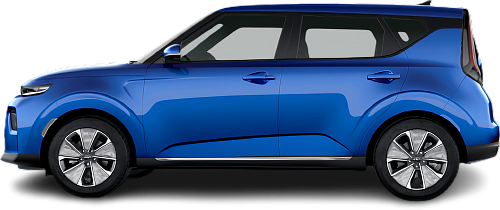USA EV Comparison: Kia Soul EV Standard Range vs Tesla Model S 60D
Struggling to Decide? Let AI Help!
Your AI Summary Is Ready!
General Info
While the Kia Soul EV Standard Range (2020-…) is currently produced, it is not offered for sale in the United States. The Tesla Model S 60D (2016-2017) has been discontinued. You can find it for as low as $15000 on the used car market.
The Kia Soul EV Standard Range (2020-…) is a SUV, whereas the Tesla Model S 60D (2016-2017) is a Liftback.
| Property | Kia Soul EV Standard Range | Tesla Model S 60D |
|---|---|---|
| Years of Production | 2020-… | 2016-2017 |
| Current Status | Produced | Discontinued |
| Country of Manufacture | South Korea | Netherlands, USA |
| Body Style | SUV | Liftback |
| Market Availability | EU | USA |
| Price USA (Used) | - Price USA (Used) | $15000 |
| GCC Score | 5.1 | 5.8 |
Range and Efficiency
While the Tesla Model S 60D (2016-2017) offers a longer real-world range and a bigger battery, it is less energy-efficient than the Kia Soul EV Standard Range (2020-…).
| Property | Kia Soul EV Standard Range | Tesla Model S 60D |
|---|---|---|
| Range (EPA) | - Range (EPA) | 218 mi |
| Range (WLTP) | 171 mi | - Range (WLTP) |
| Range (GCC) | 146 mi | 199 mi |
| Battery Capacity (Nominal) | 42 kWh | 75 kWh |
| Battery Capacity (Usable) | 39.2 kWh | 62 kWh |
| Efficiency per 100 mi | 26.8 kWh/100 mi | 31.2 kWh/100 mi |
| Efficiency per kWh | 3.72 mi/kWh | 3.21 mi/kWh |
| Range and Efficiency Score | 5.4 | 5.4 |
Charging
Both vehicles utilize a standard 400-volt architecture.
The Tesla Model S 60D (2016-2017) offers faster charging speeds at DC stations, reaching up to 120 kW, while the Kia Soul EV Standard Range (2020-…) maxes out at 44 kW.
The Tesla Model S 60D (2016-2017) features a more powerful on-board charger, supporting a maximum AC charging power of 11.5 kW, whereas the Kia Soul EV Standard Range (2020-…) is limited to 7.2 kW.
| Property | Kia Soul EV Standard Range | Tesla Model S 60D |
|---|---|---|
| Max Charging Power (AC) | 7.2 kW | 11.5 kW |
| Max Charging Power (DC) | 44 kW | 120 kW |
| Architecture | 400 V | 400 V |
| Charge Port | CCS Type 2 | Tesla (NACS) |
| Charging Score | 4 | 6.1 |
Performance
The Kia Soul EV Standard Range (2020-…) is front-wheel drive, while the Tesla Model S 60D (2016-2017) offers an all-wheel drive system.
The Tesla Model S 60D (2016-2017) boasts greater motor power and accelerates faster from 0 to 60 mph.
| Property | Kia Soul EV Standard Range | Tesla Model S 60D |
|---|---|---|
| Drive Type | FWD | AWD |
| Motor Type | PMSM | PMSM (front), IM (rear) |
| Motor Power (kW) | 100 kW | 245 kW |
| Motor Power (hp) | 134 hp | 329 hp |
| Motor Torque | 291 lb-ft | 387 lb-ft |
| 0-60 mph | 9.5 s | 5.2 s |
| Top Speed | 97 mph | 130 mph |
| Performance Score | 3.1 | 5.3 |
Dimensions
The Tesla Model S 60D (2016-2017) is longer and wider, but the Kia Soul EV Standard Range (2020-…) is taller.
The Tesla Model S 60D (2016-2017) boasts a more extended wheelbase.
| Property | Kia Soul EV Standard Range | Tesla Model S 60D |
|---|---|---|
| Length | 165.2 in | 195.7 in |
| Width (with Mirrors) | - Width (with Mirrors) | 86.2 in |
| Width (w/o Mirrors) | 70.9 in | 77.3 in |
| Height | 63.2 in | 56.9 in |
| Wheelbase | 102.4 in | 116.5 in |
Cargo and Towing
The Tesla Model S 60D (2016-2017) provides more cargo capacity, featuring both a larger trunk and more space with the rear seats folded.
A frunk (front trunk) is available in the Tesla Model S 60D (2016-2017), but the Kia Soul EV Standard Range (2020-…) doesn’t have one.
Neither vehicle is officially rated for towing in the US.
| Property | Kia Soul EV Standard Range | Tesla Model S 60D |
|---|---|---|
| Number of Seats | 5 | 5, 7 |
| Curb Weight | 3549 lb | 4647 lb |
| Cargo Volume (Trunk) | 11.1 ft3 | 26.3 ft3 |
| Cargo Volume (Max) | 47.3 ft3 | 58.1 ft3 |
| Cargo Volume (Frunk) | - Cargo Volume (Frunk) | 2.1 ft3 |
| Towing Capacity | - Towing Capacity | - Towing Capacity |
| Cargo and Towing Score | 5.5 | 5.5 |




